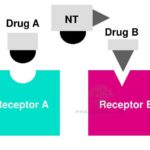Adenosine
Adenosine is antiarrhythmic agent that is widely used for the investigation and management of both narrow complex and, less often, broad complex tachycardias. It produces a transient block in the atrioventricular node. This effect is mediated by interaction with A1 receptors (reducing cyclic adenosine monophosphate) present on myocytes, thereby activating potassium channels, which increases K+ efflux, causing cell hyperpolarization.
Adenosine is considered first-line therapy for the investigation and termination of supraventricular tachycardias because of its efficacy and safety. It is also being used in some areas to aid in the diagnosis of broad complex tachycardias, usually if they have not responded to lignocaine (lidocaine).
Mechanism & Clinical Use
- Naturally occurring nucleoside with a half-life of less than 10 seconds.
- Activates inward rectifier K+ current and inhibits calcium current.
- Highly effective (90–95%) for converting paroxysmal supraventricular tachycardia to sinus rhythm.
Toxicity
- Causes flushing, shortness of breath, or chest burning in some patients.
- May induce high-grade AV block or atrial fibrillation but effects are short-lived.
Digoxin
Digoxin is a cardiac glycoside that has been used for many years in the treatment of heart failure and arrhythmias. It is derived from the foxglove plant, Digitalis lanata. While its primary indication is for the treatment of heart failure, it also has antiarrhythmic properties that make it useful in managing certain types of cardiac arrhythmias, particularly atrial fibrillation and atrial flutter.
Mechanism of Action
Digoxin works by inhibiting the sodium-potassium ATPase pump in the myocardial (heart muscle) cells. This action increases intracellular sodium levels, which in turn promotes the exchange of intracellular sodium for extracellular calcium via the sodium-calcium exchanger. The net effect is an increase in intracellular calcium, which enhances cardiac contractility.
In terms of its antiarrhythmic effects, digoxin slows down the conduction of electrical impulses through the atrioventricular (AV) node. This is particularly useful in conditions like atrial fibrillation or atrial flutter, where electrical impulses can bombard the AV node at a very high rate. By slowing down AV nodal conduction, digoxin helps to control the ventricular rate, making it more regular and often slower.
Pharmacokinetics
Digoxin has a narrow therapeutic index, meaning that the difference between an effective dose and a toxic dose is small. It is primarily excreted by the kidneys, so dose adjustments are necessary in patients with renal impairment.
Adverse Effects
The narrow therapeutic index also means that digoxin has a high potential for toxicity. Symptoms of digoxin toxicity can include nausea, vomiting, diarrhea, confusion, and visual disturbances. More seriously, digoxin toxicity can lead to life-threatening arrhythmias, including ventricular tachycardia and ventricular fibrillation.
Clinical Use
In the modern era, the use of digoxin for arrhythmias has declined due to the development of other antiarrhythmic drugs that are more effective and have better safety profiles. However, it is still used in specific cases where other treatments are not suitable or have failed.
Monitoring
Due to its narrow therapeutic window, patients on digoxin are closely monitored. Serum levels of the drug, as well as renal function, are regularly checked. Electrocardiograms may also be performed to monitor the drug’s effects on the heart’s electrical activity.
In summary, while digoxin is primarily used for heart failure, its ability to slow down AV nodal conduction makes it useful as an antiarrhythmic agent in specific cases. However, its narrow therapeutic index and potential for serious adverse effects mean that it must be used cautiously, with regular monitoring.
Ivabradine
Mechanism & Clinical Use
- Selective blocker of the “funny” current (If) in the SA node.
- Slows pacemaker activity without affecting myocardial contractility or ventricular repolarization.
- Used for heart rate control in coronary artery disease and congestive heart failure.
Toxicity
- Visual disturbances have been described.
Vernakalant
Mechanism & Clinical Use
- Multi-ion channel blocker.
- Effective for rapid termination of atrial fibrillation in patients with minimal structural heart disease.
Toxicity
- Sinus bradycardia and hypotension are the main cardiovascular adverse effects.
Magnesium
Mechanism & Clinical Use
- Influences Na+/K+-ATPase, sodium channels, certain potassium channels, and calcium channels.
- Used in digitalis-induced arrhythmias and torsades de pointes.
Toxicity
- Further investigation needed to understand its action and indications fully.
Conclusion
These miscellaneous agents offer a range of mechanisms and clinical uses for treating arrhythmias. While some are well-established in clinical practice, others are still under investigation. Each comes with its own set of benefits and risks, making it crucial to tailor the choice of antiarrhythmic agent to the individual patient’s needs.
Note: This article is intended for educational purposes and should not be considered as medical advice. Always consult with a healthcare professional for medical advice and treatment.
📚 AI Pharma Quiz Generator
🎉 Quiz Results
Medical Disclaimer
The medical information on this post is for general educational purposes only and is provided by Pharmacology Mentor. While we strive to keep content current and accurate, Pharmacology Mentor makes no representations or warranties, express or implied, regarding the completeness, accuracy, reliability, suitability, or availability of the post, the website, or any information, products, services, or related graphics for any purpose. This content is not a substitute for professional medical advice, diagnosis, or treatment; always seek the advice of your physician or other qualified health provider with any questions you may have regarding a medical condition and never disregard or delay seeking professional advice because of something you have read here. Reliance on any information provided is solely at your own risk.









